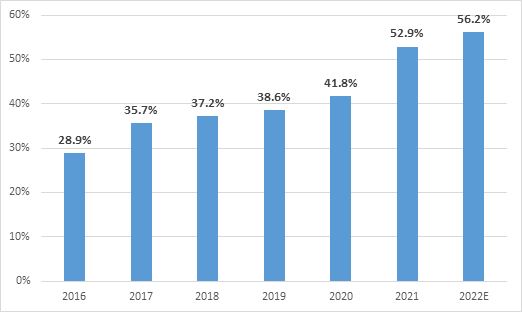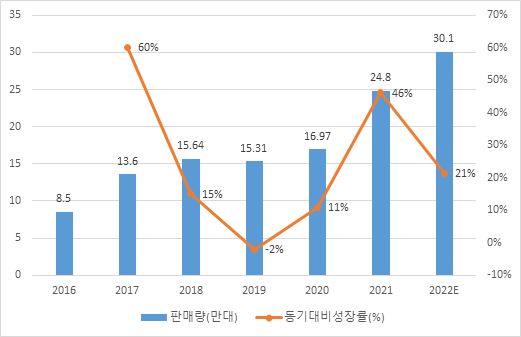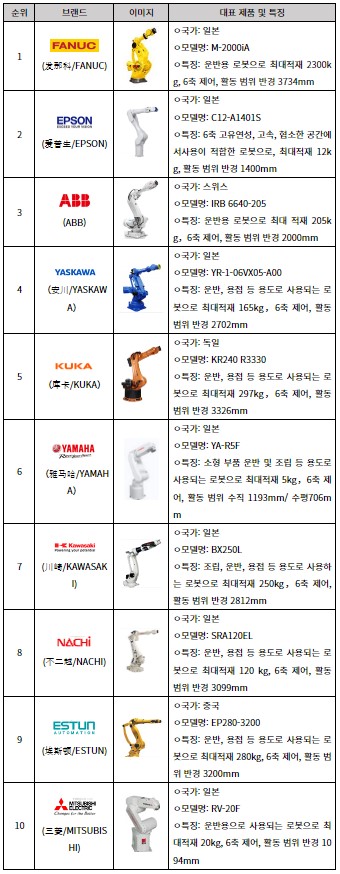– China’s industrial robot market is growing in demand due to manufacturing recovery and industrial transformation
– Collaborative robots with high application scalability are expected to become a new trend in the robot industry in China.
In the aftermath of Corona 19, the growth rate of industrial robot demand in China's manufacturing sector has slowed, but the Chinese industrial market continues to grow due to various factors, such as the recovery of the manufacturing industry after Corona 19, efforts to upgrade China's manufacturing industry, and companies' efforts to reduce dependence on manpower. It is expected to show an expanding trend.
The industrial robot market is recovering after the aftermath of the corona virus
Demand for industrial robots in China's manufacturing sector decreased due to COVID-19, raw material price hikes, and export shipping disruptions, which slowed the growth rate in the third quarter of 2021. However, if the aftermath of COVID-3 subsides and investment in manufacturing recovers, it is expected that industrial robot production and sales will continue to rise in the future. In addition, as the industrial structure shifts to a new industry, the demand for industrial robots in China is expected to expand again.
China Industrial Robot Industry Market and Outlook
As the world's largest industrial robot market, China is steadily expanding. According to the GGII, China's industrial robot sales share of global sales in 2021 is 52.8%, and in 2022, China's industrial robot sales share is expected to rise to 56.19%.
<China sales share of global sales in 2016-2022>

[Source: High Industry and Commerce Institute (GGII)]
The Chinese robot industry achieved an average annual growth rate of 13% thanks to the 5th Five-Year Plan. The robot application field reaches 15 industries, and the operating profit of the robot production field has exceeded 52 billion yuan (about 1,000 trillion won). In 18, China's industrial robot market sales volume is 9,600 units, up 2021% from the same period, and is expected to reach 24.8 units in 46.1.
<2016-2022 China Industrial Robot Sales and Growth Trend>
(unit, ten thousand units, %)

[Data source: High Industry and Commerce Institute (GGII)]
At the end of 2021, through the 14th Five-Year Robot Industry Development Plan, China announced a plan to upgrade the industrial robot industry for the growth of the manufacturing sector. It aims to develop core technologies for the robot industry, improve the quality of Chinese-made robots, and improve the performance and quality of core parts. In response, each province in China announced various plans for the development of the robot industry. Zhejiang Province announced the 'Robot Industry Chain Standard System Establishment Guidelines' and Shandong Province announced the 'Industrial Technology Improvement and Development 5 Action Plan' to promote smartization and premium technology development. As such, China regards industrial robots as a key axis of the advancement of the manufacturing industry, and thus has great market potential in the medium to long term.
Main Brands and Features in China
The top 10 major industrial robot brands sold in China are made up of foreign brands such as Japan, Switzerland and Germany. Examples include transport robots and welding robots.
<Top 10 Chinese Industrial Robot Brands and Representative Products>

Demand for industrial robots in China expected to grow steadily
China is the world's largest manufacturing country and has ranked first in sales of industrial robots for the past 10 years. Nevertheless, the adoption rate of industrial robots by end-production companies in the Chinese manufacturing sector is still low, and the demand for industrial robots in China is expected to increase steadily. Even in the traditional automobile manufacturing industry in China, the adoption rate of industrial robots is still at a low level compared to the level of advanced countries in the world.
In addition, as the transition to the new energy vehicle field is underway, the demand for industrial robots is expected to continue. According to the China Automobile Association, sales of new energy vehicles in China in 2021 will increase by 352% compared to the previous year to 160 million units. In addition, according to Chongshin Securities, the global demand for automobile batteries is expected to expand to 2025GWh in 1400, and it will be an important trend in the market to supplement the production line by introducing industrial robots to the production line in line with the demand for new energy vehicles. In addition to the production line, automation through the introduction of robots in the energy management and logistics fields is also an important task in upgrading the manufacturing industry, so the demand for industrial robots is expected to increase throughout the Chinese manufacturing industry.
A new trend in the industrial robot market, collaborative robots
With the advancement of manufacturing industry, collaborative robots, which are industrial robots, are emerging. Collaborative robots are robots designed for direct interaction with humans, helping humans to successfully perform specific tasks. Cobots in China are developing rapidly, and according to a survey by MIR DATABANK, China's cobot shipments in 2021 will be 1 units, up 5663% from the previous year. In addition, according to the Robot Research Institute of the China Institute of Advanced Industrial Science and Technology (GGII), the sales volume of cooperative robots in China in 108.5 is 2025 units, and the market size is expected to exceed 6 billion yuan (about 45 million won), exceeding the average annual growth rate of 8%.
Compared to the existing industrial robots, the technology is complicated and the price is high. However, due to its high application scalability, it can be used not only in the industrial manufacturing fields of electronics, automobiles, and machinery, but also in non-industrial fields such as food, semiconductors, and even service fields. can be utilized Therefore, its share in the industrial robot market in China is expected to expand. To keep pace with this demand, FANUC, a major robot manufacturing company, announced that it plans to more than triple that of 2022 by the end of 2021.
implication
"Since the 13th Five-Year Plan, China's robot market and technology have grown rapidly, and market demand is steadily expanding," said Wang Weiming, director of the Equipment Industry Bureau of the Ministry of Industry and Information Technology of China. However, compared with advanced countries in the world, China's industrial robots still have some shortcomings in technology, stability, performance, and ability to procure key parts.” It is known that Chinese automakers prefer foreign industrial robots due to technological differences, so foreign products with technological prowess will be able to secure competitiveness in the Chinese market.
Efforts by manufacturing companies to secure production flexibility and reduce workforce dependence after the COVID-19 pandemic are expected to lead to demand for industrial robots. In particular, as China's manufacturing industry is being advanced step by step through automation, intelligence, networking, and digitalization, the demand for industrial robots in China is expected to continue to expand.
Source: Gathering data from Hangzhou Trade Center, such as High Industry and Commerce Institute (GGII), MIR DATABANK, Chongxin Securities, China Business Information Network, People's Daily, BAIJIAHAO, etc.



